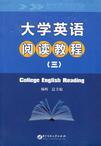大学英语阅读教程
出版时间:2009-7 出版社:华中科技大学出版社 作者:杨辉 编 页数:142
内容概要
本教程共分四册,第一册围绕“运用语言技能理解文章”这一层面的阅读技能展开训练;第二册重点解析和训练“辨别和理解中心思想和重要细节”这一层面的阅读技能;第三册训练“运用专门的阅读技能(略读、查读)”这一层面的阅读技能;第四册提高难度,把前三册的阅读技能贯穿于其中。每册分为8个单元,各单元由同一题材的2篇文章、生词注释、有关文化背景介绍、练习等组成。为了配合学生参加大学英语四、六级考试,每个单元增加阅读训练部分,由3篇配有选择练习题的小短文组成;同时在主课文的练习中,增加了汉译英练习。 本套教程的编写体现了如下特点。 (1)本教程由具有丰富的教学经验的大学英语教师分工协作、集体编写而成,具有很强的专业性。 (2)本教程在编写过程中充分吸收我国在外语教学方面长期积累起来的行之有效的经验和方法,取各家之长,兼容并蓄,能适应多种英语教学的要求。 (3)本教程旨在通过教师的“精讲”和学生的“多练”来提高学生学习的主动性、积极性和创造性。 (4)本教程选用当代英语常见语体或文体的典型样本作为素材,内容新颖,搜选范围主要是近五年来英美国家出版的图书、报纸、杂志或最新的网络文章,涵盖教育、科技、政治、经济和文化等各个方面,阅读文章素材具有时代性、可读性、文化教育性和针对性。 (5)本教程练习题型的设计均按照最新的大学英语四、六级考试标准和难度进行。文章后附设了6种题型:一是快速阅读(包括是非判断题和句子填空题);二是阅读理解(多项选择题);三是篇章理解(选词填空题),依据阅读文章的内容,编出一篇小短文,留出10个空,给出15个词供读者进行选择填空;四是简答题,一般用问句形式命题,要求读者作简短回答;五是翻译题,共5个句子,句中一部分已用英文给出,要求学生根据全句意思将汉语部分译成英语;六是讨论题,对文章内容提出2个问题,供学生讨论。各题型的题量适当,这样可以帮助学生逐步熟悉考试形式,更好地为四、六级考试作准备。
书籍目录
Unit 1 Changes in the Way We Live Part 1 Reading Text Part 2 Reading Practice Part 3 Home ReadingUnit 2 Civil Rights Heroes Part 1 Reading Text Part 2 Reading Practice Part 3 Home ReadingUnit 3 Security Part 1 Reading Text Part 2 Reading Practice Part 3 Home ReadingUnit 4 Extraterrestrials Part 1 Reading Text Part 2 Reading Practice Part 3 Home ReadingUnit 5 How to Celebrate Holidays Part 1 Reading Text Part 2 Reading Practice Part 3 Home ReadingUnit 6 The Human Touch Part 1 Reading Text Part 2 Reading Practice Part 3 Home ReadingUnit 7 Life of Salesman Part 1 Reading Text Part 2 Reading Practice Part 3 Home ReadingUnit 8 Cloning Part 1 Reading Text Part 2 Reading Practice Part 3 Home Reading
章节摘录
Through resolutions and discussions within the United Nations, a general agreement has developed that an arms race in outer space should be prevented. However, due to the structure of the international legal regime and to the objection of a (very) few states, a treaty has not yet been negotiated to comprehensively prevent an arms race in outer space. The work of the UN, then, is to determine the steps toward negotiating a treaty. To imply that since an arms race does not yet exist, and therefore it is not necessary to take action, is unacceptable. On the contrary, because there is not yet an arms race, now is the time to prevent weaponization of space. If this does not happen now, very soon the talk will be on "nonproliferation" rather than "prevention". Outer space is said to be used only for peaceful purposes. Although the term "peaceful purposes" was never clearly defined, it was accepted that this included military, commercial, scientific and development uses. Since the early days of the space race the international community has referred to the use of "space for peaceful purposes", and to the need to maintain a "space sanctuary". But a distinction must be made between militarization and weaponization of space. Although space is heavily militarized, it is not yet weaponized. Space weaponization is generally understood to refer to the placement in orbit of space based devices that have a destructive capacity. Space has been militarized since the earliest communication satellites were launched. Today, militaries all over the world rely heavily on satellites for command and control, communication, monitoring, early warning and navigation with the Global Positioning System (GPS). Therefore, most states accept that "peaceful purposes" include military use, even that which is not particularly peaceful, and space is considered a sanctuary only in that no weapons are deployed there.
图书封面
评论、评分、阅读与下载
用户评论 (总计0条)
推荐图书
- 中考词汇全解/英语高手
- 中考专项突破
- 中考专项突破
- 中考语法考点详解/英语高手
- 中考专项突破
- 作文高手五年中考满分作文典藏
- 2005-2009 五年满分作文典藏/作文高手
- 作文高手中考满分作文鲜读
- 轻松课堂单元综合检测·语文
- 数学
- 轻松课堂·单元综合检测(上册)
- 轻松课堂·单元综合检测(上册)
- 数学
- 轻松课堂·单元综合检测(上册)
- 文言文课外拓展训练
- 中国机械工业标准汇编 阀门卷(上)
- 对物品中物质要求的指南
- GB/T19001-2008与内部审核员培训解疑释惑250题
- 经济法概论
- 中级财务会计习题与案例
- 消费者行为学
- 体坛说法
- 企业社会责任会计研究
- 中国现阶段收入分配公平问题研究
- 中考专项突破
